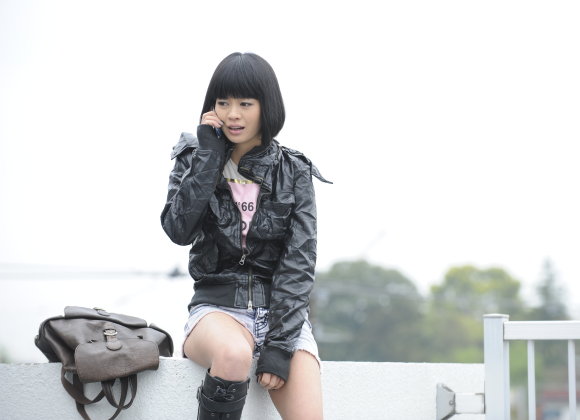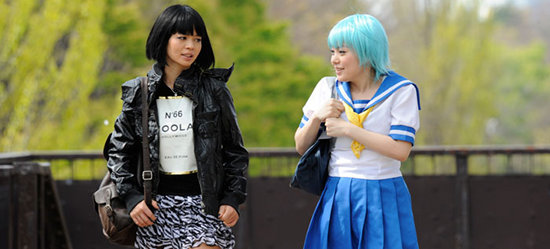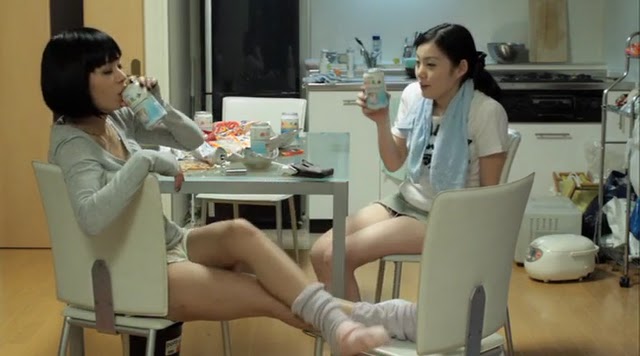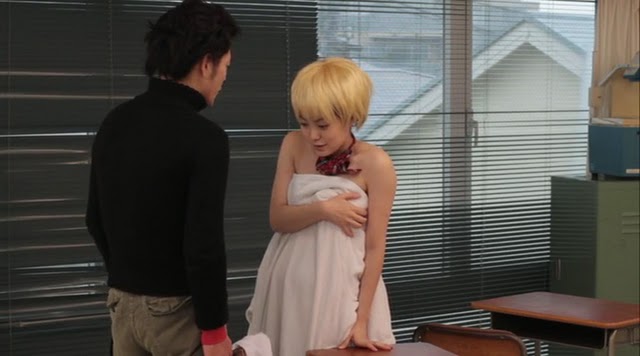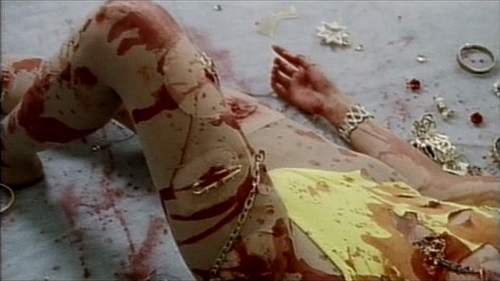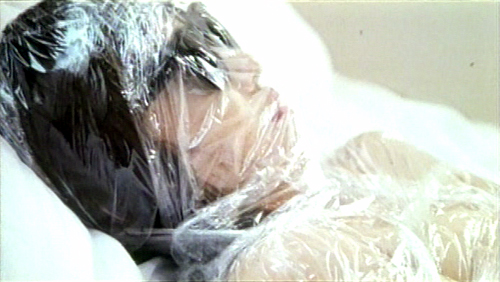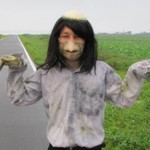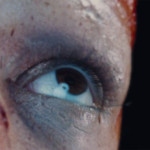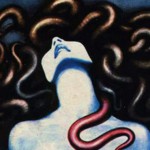‘Pink Devil’ HISAYASU SATO talks about his irrepressible desires
‘Pink Devil’ HISAYASU SATO talks about his irrepressible desires
Interview by Kier-La Janisse
——————
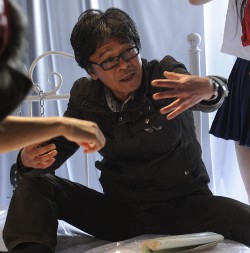 Not many of Hisayasu Sato’s films have made it over here to North America in any legitimate form, but those who were traumatized by Naked Blood and The Bedroom are well aware of his reputation as one of the most button-pushing independent directors in Japan. Working primarily in the pinku genre – and considered one of the Pink Shitenno, or ‘Pink Devils’ along with Kazuhiro Sano, Toshiki Sato and Takahisa Zeze – Sato has habitually broken down the art/smut barrier to attract significant critical attention. His films have always exploited the narrative potential of the genre as much as its erotic potential, bringing in the kinds of socio-political issues that were prized by forefathers like Koji Wakamatsu in the 1960s; his films are often dark and apocalyptic, sexually transgressive and full of vile imagery that historically doesn’t do much for the raincoat crowd but has won him a legion of fans in genre circles.
Not many of Hisayasu Sato’s films have made it over here to North America in any legitimate form, but those who were traumatized by Naked Blood and The Bedroom are well aware of his reputation as one of the most button-pushing independent directors in Japan. Working primarily in the pinku genre – and considered one of the Pink Shitenno, or ‘Pink Devils’ along with Kazuhiro Sano, Toshiki Sato and Takahisa Zeze – Sato has habitually broken down the art/smut barrier to attract significant critical attention. His films have always exploited the narrative potential of the genre as much as its erotic potential, bringing in the kinds of socio-political issues that were prized by forefathers like Koji Wakamatsu in the 1960s; his films are often dark and apocalyptic, sexually transgressive and full of vile imagery that historically doesn’t do much for the raincoat crowd but has won him a legion of fans in genre circles.
Hisayasu Sato will appear at Fantasia in person to present his latest pink film Love & Loathing & Lulu & Ayano on July 21 + 23 (full details on the film page HERE), marking a rare occasion to meet one of the most legendary auteurs of Japanese cinema. The following exclusive interview had to be simplified due to language issues, but still, it’s Hisayasu Sato. Kind of a big deal.
———————
The cute Otaku flourishes in Fear + Loathing + Lulu + Ayano are definitely a departure from the more sobering psychosexual aspects of your earlier films (The Bedroom, Lolita: Vibrator Torture, Naked Blood etc). Was there a reason you shifted to softer material over time?
The film is based on the interviews with porno stars revealing their background. You tend to see those kind of girls with prejudiced eyes, however in the interview, you discover that they think just like the girls in general. I find the content of the interview is like a miniature version of this distorted society.
I wanted all the audience to watch this film without age restriction (R-rated, 15, etc), especially young girls. I wanted depict the strength of the girls who try to confront this corrupted society without giving up.
The friendship that develops between the two female characters in Fear + Loathing + Lulu + Ayano is interesting – did you see friendships like this ever develop on the sets of your own films?
I guess this kind of friendship can be developed on the set with more difficulties, anyway, usually they won’t show it to the directors. In our case, it was the first time acting in a film for Yasui (Lulu) and there was a scene where Lulu exposes herself, being completely naked both mentally and physically. Sakuma (Ayano) apparently tried to cheer her up saying like “No other choice, have to do it. Let’s do it!” I think because of their good relationship, this scene became really exciting without any test shooting.
I don’t know if their friendship grew further after the film or not.
Is it common to have very shy girls take up roles in these films as a means of expressing repressed emotions or fantasies?
Those girls are usually very sensitive and have difficulty expressing themselves. While they oppress themselves in daily life, they glow in the film. My job is to catch this highlighted moment.
Why do you think the character Lulu is not able to apply her newfound confidence in real life? Instead she disassociates and becomes the character, rather than letting the character’s positive aspects affect her real life.
The character has been acting out a role her mother desired her to be. She has been always wearing this mask, and it was her daily life. Then she decided to discover new aspect of herself, but it is not a safe refuge. Still the journey of asking herself questions and trying to find her own place will continue.
When you first started making pink films, did you see them as a fitting platform for your more subversive ideas?
The pink film was only means for young directors to shoot films with a low budget. Destruction and creation are two sides of the same coin. I was saved by shooting film; if not for film I might have become a criminal.
One of the interesting things about Fear + Loathing + Lulu + Ayano is that every consequence of porn – the relationships, disguises, confrontations, threats, fans etc – are self-reflexively addressed, and yet the film still remains a porn film. Many of your films have overtly satirical elements – can you describe your relationship to satire, and how you applied it to this film?
The inconvenient things for society to deal with are usually hidden in a closed room, and I am tempted to open this door. There are dirty and dark desires inside every human. My film is like a mirror; if you watch it, you will see your inner face.
When did you first develop a fascination for voyeurism? This is an ongoing theme in many of your films.
I don’t remember exactly when, but probably when I started being interested in girls. I wanted to know what they think of me and I wanted to know their mind. I guess it comes from my desires from childhood. I used to get excited imagining what kind of crazy things are going on behind the curtain. I guess it is human nature to desire to know something hidden. The more hidden, the stronger our desire gets.
Like the character in Naked Blood, you also have a character in Fear + Loathing + Lulu + Ayano who seems to be called to the sea – what is the relationship between these characters and the sea?
As you know Japan is an island surrounded by sea. It is natural for us to scream to the sea or stay silent to think deeply by the sea when you are stressed. I used to dream of something different from this reality over sea. It is also said that the sound of heartbeat of the mother that the baby listens inside of the womb is similar to the sound of waves. The sea might connect to the root of human life.
I can say it is the place where you can face your own mind.
Have you deliberately tried to court controversy with some of your films – for example, getting the notorious cannibal Sagawa Issei (warning before clicking this link: graphic imagery) to appear in The Bedroom in a cameo role, or having bestiality in the film Horse and Woman and Dog (1990)?
Not intentional. I just follow what I desire, and it is necessary to express myself.
Why is rape and rape fantasy such an important part of pink films?
In my pink films, a rape scene means the destruction, communication and proof of existence of this distorted society. To me, Japan is society of maternity. We always have a desire to be approved by mother. Anyway the rape is just metaphor (if you do it in real life, it is criminal).
You’ve also been credited as one of the first pinku directors to make films for gay audiences or that focused on gay themes. What kinds of things can you explore in a gay pink film that is different from a heterosexual film?
I feel that it is more platonic. Gay people are usually discriminated against and oppressed by society. They have to believe in their love, but the more they love, the more they get hurt. It is also the boundary with society. And the real beauty is born there.
————-
Thanks to Serina Nishioka for intermediary translation!

 July 21, 2011
July 21, 2011  No Comments
No Comments
